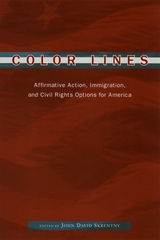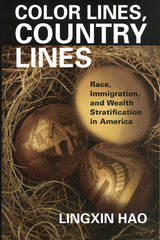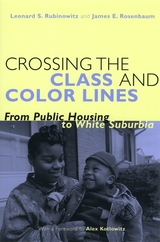3 books about Color Lines

Color Lines
Affirmative Action, Immigration, and Civil Rights Options for America
John David Skrentny
University of Chicago Press, 2001
A new ethnic order has emerged in the United States. The growing number of Latinos and Asians has rendered the old black-and-white binary obsolete. And yet, political pundits and commentators on both the left and the right continue to overlook the changing face of discrimination and opportunity in today's new multiethnic, multiracial America. With Color Lines, John David Skrentny brings us a collection of essays that reexamines the role of affirmative action and civil rights in light of this important shift in American demographics. The book explores issues of public policy, equal opportunity, diversity, multiculturalism, pathways to better work and higher learning, and attempts in countries outside the United States to protect minority civil rights. Combining perspectives from specialists in fields as diverse as sociology, history, political science, and law, Color Lines is a balanced and broad-ranging guide for anyone interested in civil rights policy and the future of ethnic relations in America.
Contributors:
Erik Bleich
Lawrence D. Bobo
Frank Dobbin
John Aubrey Douglass
Hugh Davis Graham
Kyra R. Greene
Erin Kelly
George R. La Noue
Jennifer Lee
Michael Lichter
Deborah C. Malamud
Sunita Parikh
John C. Sullivan
Thomas J. Sugrue
Carol M. Swain
Steven M. Teles
Roger Waldinger
Christine Min Wotipka
Contributors:
Erik Bleich
Lawrence D. Bobo
Frank Dobbin
John Aubrey Douglass
Hugh Davis Graham
Kyra R. Greene
Erin Kelly
George R. La Noue
Jennifer Lee
Michael Lichter
Deborah C. Malamud
Sunita Parikh
John C. Sullivan
Thomas J. Sugrue
Carol M. Swain
Steven M. Teles
Roger Waldinger
Christine Min Wotipka
[more]

Color Lines, Country Lines
Race, Immigration, and Wealth Stratification in America
Lingxin Hao
Russell Sage Foundation, 2007
The growing number of immigrants living and working in America has become a controversial topic from classrooms to corporations and from kitchen tables to Capitol Hill. Many native-born Americans fear that competition from new arrivals will undermine the economic standing of low-skilled American workers, and that immigrants may not successfully integrate into the U.S. economy. In Color Lines, Country Lines, sociologist Lingxin Hao argues that the current influx of immigrants is changing America's class structure, but not in the ways commonly believed. Drawing on twenty years of national survey data, Color Lines, Country Lines investigates how immigrants are faring as they try to accumulate enough wealth to join the American middle class, and how, in the process, they are transforming historic links between race and socioeconomic status. Hao finds that disparities in wealth among immigrants are large and growing, including disparities among immigrants of the same race or ethnicity. Cuban immigrants have made substantially more progress than arrivals from the Dominican Republic, Chinese immigrants have had more success than Vietnamese or Korean immigrants, and Jamaicans have fared better than Haitians and immigrants from sub-Saharan Africa. Indeed, many of these immigrant groups have acquired more wealth than native-born Americans of the same race or ethnicity. Hao traces these diverging paths to differences in the political and educational systems of the immigrants' home countries, as well as to preferential treatment of some groups by U.S. immigration authorities and the U.S. labor market. As a result, individuals' country of origin increasingly matters more than their race in determining their prospects for acquiring wealth. In a novel analysis, Hao predicts that as large numbers of immigrants arrive in the United States every year, the variation in wealth within racial groups will continue to grow, reducing wealth inequalities between racial groups. If upward mobility remains restricted to only some groups, then the old divisions of wealth by race will gradually become secondary to new disparities based on country of origin. However, if the labor market and the government are receptive to all immigrant groups, then the assimilation of immigrants into the middle class will help diminish wealth inequality in society as a whole. Immigrants' assimilation into the American mainstream and the impact of immigration on the American economy are inextricably linked, and each issue can only be understood in light of the other. Color Lines, Country Lines shows why some immigrant groups are struggling to get by while others have managed to achieve the American dream and reveals the surprising ways in which immigration is reshaping American society.
[more]

Crossing the Class and Color Lines
From Public Housing to White Suburbia
Leonard S. Rubinowitz and James E. Rosenbaum
University of Chicago Press, 2000
From 1976 to 1998, the Gautreaux Assisted Housing Program moved over 7,000 low-income black families from Chicago's inner city to middle-class white suburbs—the largest and longest-running residential, racial, and economic integration effort in American history. Crossing the Class and Color Lines is the story of that project, from the initial struggles and discomfort of the relocated families to their eventual successes in employment and education—cementing the sociological concept of the "neighborhood effect" and shattering the myth that inner-city blacks cannot escape a "culture of poverty."
"This book's history of Chicago public housing should be required reading for anyone interested in social policy in the United States."—Jens Ludwig, Social Service Review
"[The authors'] work is rightly cited as one of the important precedents in the field. . . . This is a remarkable, unassailable accomplishment and this book is an important record of their scholarly contribution."—John M. Goering, Ethnic and Racial Studies
"This book's history of Chicago public housing should be required reading for anyone interested in social policy in the United States."—Jens Ludwig, Social Service Review
"[The authors'] work is rightly cited as one of the important precedents in the field. . . . This is a remarkable, unassailable accomplishment and this book is an important record of their scholarly contribution."—John M. Goering, Ethnic and Racial Studies
[more]
READERS
Browse our collection.
PUBLISHERS
See BiblioVault's publisher services.
STUDENT SERVICES
Files for college accessibility offices.
UChicago Accessibility Resources
home | accessibility | search | about | contact us
BiblioVault ® 2001 - 2024
The University of Chicago Press









